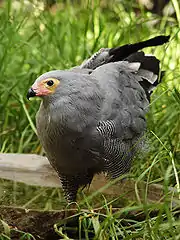| Polyboroides[1] | |||
| A. Smith, 1829[2] | |||
 Przedstawiciel rodzaju – owadożer palmowy (P. typus) | |||
| Systematyka | |||
| Domena | |||
|---|---|---|---|
| Królestwo | |||
| Typ | |||
| Podtyp | |||
| Gromada | |||
| Podgromada | |||
| Infragromada | |||
| Rząd | |||
| Rodzina | |||
| Podrodzina | |||
| Plemię | |||
| Rodzaj |
Polyboroides | ||
| Typ nomenklatoryczny | |||
|
Polyboroides typus A. Smith, 1829 | |||
| Synonimy | |||
|
| |||
| Gatunki | |||
| |||
Polyboroides – rodzaj ptaków z podrodziny orłosępów (Gypaetinae) w rodzinie jastrzębiowatych (Accipitridae).
Zasięg występowania
Rodzaj obejmuje gatunki występujące w Afryce (w tym na Madagaskarze)[6].
Morfologia
Długość ciała 51–68 cm, rozpiętość skrzydeł 116–152 cm; masa ciała 500–950 g[6].
Systematyka
Etymologia
Podział systematyczny
Do rodzaju należą następujące gatunki[9]:
- Polyboroides typus A. Smith, 1829 – owadożer palmowy
- Polyboroides radiatus (Scopoli, 1786) – owadożer madagaskarski
Uwagi
Przypisy
- ↑ Polyboroides, [w:] Integrated Taxonomic Information System (ang.).
- ↑ A. Smith. „South African Commercial Advertiser”. 4, 1829. (ang.).
- ↑ A. Smith. A Description of the Birds inhabiting the South of Africa. „South African quarterly Journal”. 1 (2), s. 107, 1830. (ang.).
- ↑ R.-P. Lesson: Traité d’ornithologie, ou, Tableau méthodique des ordres, sous-ordres, familles, tribus, genres, sous-genres et races d’oiseaux, ouvrage entièrement neuf, formant le catalogue le plus complet des espèces réunies dans les collections publiques de la France. T. 1. Bruxelles: Chez F.G. Levrault, 1831, s. 64. (fr.).
- ↑ R. Vierthaler. Ornithologischer Tagebuchsbericht einer Reise auf dem blauen Nil von Chartum durch Sennaar nach Rosseires. „Naumannia: Archiv für die Ornithologie Vorzugsweise Europa's: Organ der Deutsche Ornithologen-Gesellschaft”. 2 (1), s. 50, 52, 1852. (niem.).
- 1 2 D.W. Winkler, S.M. Billerman & I.J. Lovette: Hawks, Eagles, and Kites (Accipitridae), version 1.0. W: S.M. Billerman, B.K. Keeney, P.G. Rodewald & T.S. Schulenberg (red.): Birds of the World. Ithaca, NY: Cornell Lab of Ornithology, 2020. DOI: 10.2173/bow.accipi1.01. [dostęp 2020-05-29]. (ang.).

- ↑ Polyboroides, [w:] The Key to Scientific Names, J.A. Jobling (red.), [w:] Birds of the World, S.M. Billerman et al. (red.), Cornell Lab of Ornithology, Ithaca [dostęp 2022-02-02] (ang.).
- ↑ Gymnogenys, [w:] The Key to Scientific Names, J.A. Jobling (red.), [w:] Birds of the World, S.M. Billerman et al. (red.), Cornell Lab of Ornithology, Ithaca [dostęp 2022-02-02] (ang.).
- ↑ Systematyka i nazwy polskie za: P. Mielczarek & M. Kuziemko: Plemię: Gypaetini Bonaparte, 1831 (Wersja: 2021-07-06). [w:] Kompletna lista ptaków świata [on-line]. Instytut Nauk o Środowisku Uniwersytetu Jagiellońskiego. [dostęp 2021-07-26].
This article is issued from Wikipedia. The text is licensed under Creative Commons - Attribution - Sharealike. Additional terms may apply for the media files.